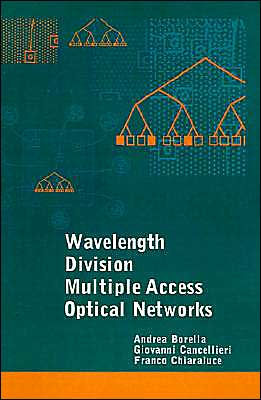| Preface | ix |
| Chapter 1 | Optical Networking | 1 |
| 1.1 | Brief History of Optical Communications | 1 |
| 1.2 | Main Features of WDMA Optical Networks | 4 |
| 1.3 | Classification | 7 |
| 1.4 | Practical Limits | 9 |
| 1.5 | Passive Components | 12 |
| 1.6 | Active Devices and Apparatuses | 14 |
| 1.7 | EDFAs | 17 |
| 1.8 | Traffic Aspects | 19 |
| References | 23 |
| Chapter 2 | Single-Hop Optical Networks | 27 |
| 2.1 | General Concepts | 27 |
| 2.2 | Transmission Protocols | 30 |
| 2.2.1 | Fixed and Semifixed Assignment Protocols | 32 |
| 2.2.2 | Random Access Protocols with No Pretransmission Coordination | 37 |
| 2.2.3 | Random Access Protocols with Pretansmission Coordination | 41 |
| 2.2.4 | Outline of Performance Comparison and Final Remarks on the Transmission Protocols | 67 |
| 2.3 | Experimental Broadcast-and-Select Single-Hop Networks | 69 |
| 2.3.1 | Lambdanet | 70 |
| 2.3.2 | Rainbow | 74 |
| 2.3.3 | Fox | 77 |
| 2.3.4 | Hypass | 79 |
| 2.3.5 | Bhypass | 86 |
| 2.3.6 | Photonic Knockout Switch | 87 |
| 2.3.7 | Passive Photonic Loop | 94 |
| 2.3.8 | Star-Track | 98 |
| 2.3.9 | Fiber Delay Line Switching Matrix | 100 |
| 2.3.10 | Symfonet | 103 |
| 2.3.11 | Mesh with Broadcast-and-Select | 108 |
| 2.4 | An Example of Wavelength-Routing WDMA Network: The Linear Lightwave Network | 112 |
| 2.4.1 | The LLN Architecture | 113 |
| 2.4.2 | Routing Constraints | 115 |
| 2.4.3 | Performance with Different Routing Schemes | 119 |
| References | 131 |
| Chapter 3 | Multihop Optical Networks | 139 |
| 3.1 | Preliminary Remarks | 139 |
| 3.1.1 | Basic Characteristics of Multihop Networks | 139 |
| 3.1.2 | Meaning and Importance of Some Performance Parameters | 140 |
| 3.2 | Manhattan Street Networks | 142 |
| 3.2.1 | Network Architecture | 142 |
| 3.2.2 | Some Topological Characteristics of a MSN | 148 |
| 3.2.3 | Distributed Routing Rules in MSNs | 149 |
| 3.2.4 | All-Optical Implementation of MSNs | 156 |
| 3.2.5 | Bidirectional MSNs | 162 |
| 3.2.6 | Characteristic Parameters of a BMSN | 164 |
| 3.2.7 | Bidirectional Manhattan Topology with Uplinks | 166 |
| 3.2.8 | Routing in BMSNs | 167 |
| 3.3 | Shuffle Networks | 175 |
| 3.3.1 | The Perfect Shuffle Topology | 175 |
| 3.3.2 | Shufflenets with Shared Channels | 179 |
| 3.3.3 | Size Modifications of Shuffle Networks Based on Multistar Architecture | 184 |
| 3.3.4 | Modular Expansion of Shufflenets | 188 |
| 3.3.5 | Channel Sharing in a Bidirectional Perfect Shuffle Topology | 189 |
| 3.3.6 | Routing in Shufflenets | 195 |
| 3.4 | Evolutions of the Shuffle Topology | 200 |
| 3.4.1 | Duplex Shufflenet | 200 |
| 3.4.2 | Gemnet | 203 |
| 3.4.3 | Enlarged Shufflenet Architecture | 208 |
| 3.4.4 | Modification of the Shufflenet Connectivity Graph | 214 |
| 3.4.5 | Banyan Net | 219 |
| 3.5 | De Bruijn Graph Topology | 227 |
| 3.5.1 | The de Bruijn Graph | 227 |
| 3.5.2 | Routing in de Brujin Networks | 228 |
| 3.5.3 | de Bruijn Versus Shufflenet | 231 |
| 3.5.4 | The Modified de Bruijn Topology | 233 |
| 3.5.5 | de Bruijn Network Variants | 236 |
| 3.6 | MATRIX Topology | 238 |
| 3.6.1 | Space Diversity to Avoid WDM Conversion | 238 |
| 3.6.2 | Network Parameters | 242 |
| 3.7 | SWIFT Architecture | 246 |
| 3.7.1 | The SWIFT Approach | 246 |
| 3.7.2 | The Data Link Layer | 247 |
| 3.7.3 | The Routing Layer | 249 |
| 3.7.4 | SWIFT Performance | 251 |
| 3.8 | Starnet Architecture | 256 |
| 3.8.1 | Starnet Basic Characteristics | 256 |
| 3.8.2 | Node Structure | 257 |
| 3.8.3 | The Circuit Switching and Packet Switching Subnetworks | 263 |
| 3.8.4 | Multihop Networks Supported by Starnet | 265 |
| References | 267 |
| Chapter 4 | Multilevel Optical Networks | 275 |
| 4.1 | Networks of Networks | 275 |
| 4.2 | Star-of-Stars Network | 276 |
| 4.3 | Hierarchical LLN | 282 |
| 4.4 | Combination of Single-Hop and Multihop Connection Modes in MONs | 285 |
| 4.4.1 | Basic Concepts for the Two-Level Case | 286 |
| 4.4.2 | Analysis and Optimization of MONs | 288 |
| 4.4.3 | Comparison with Shufflenet | 303 |
| 4.4.4 | Multiple Hierarchical Levels | 307 |
| References | 311 |
| About the Authors | 313 |
| Index | 315 |




